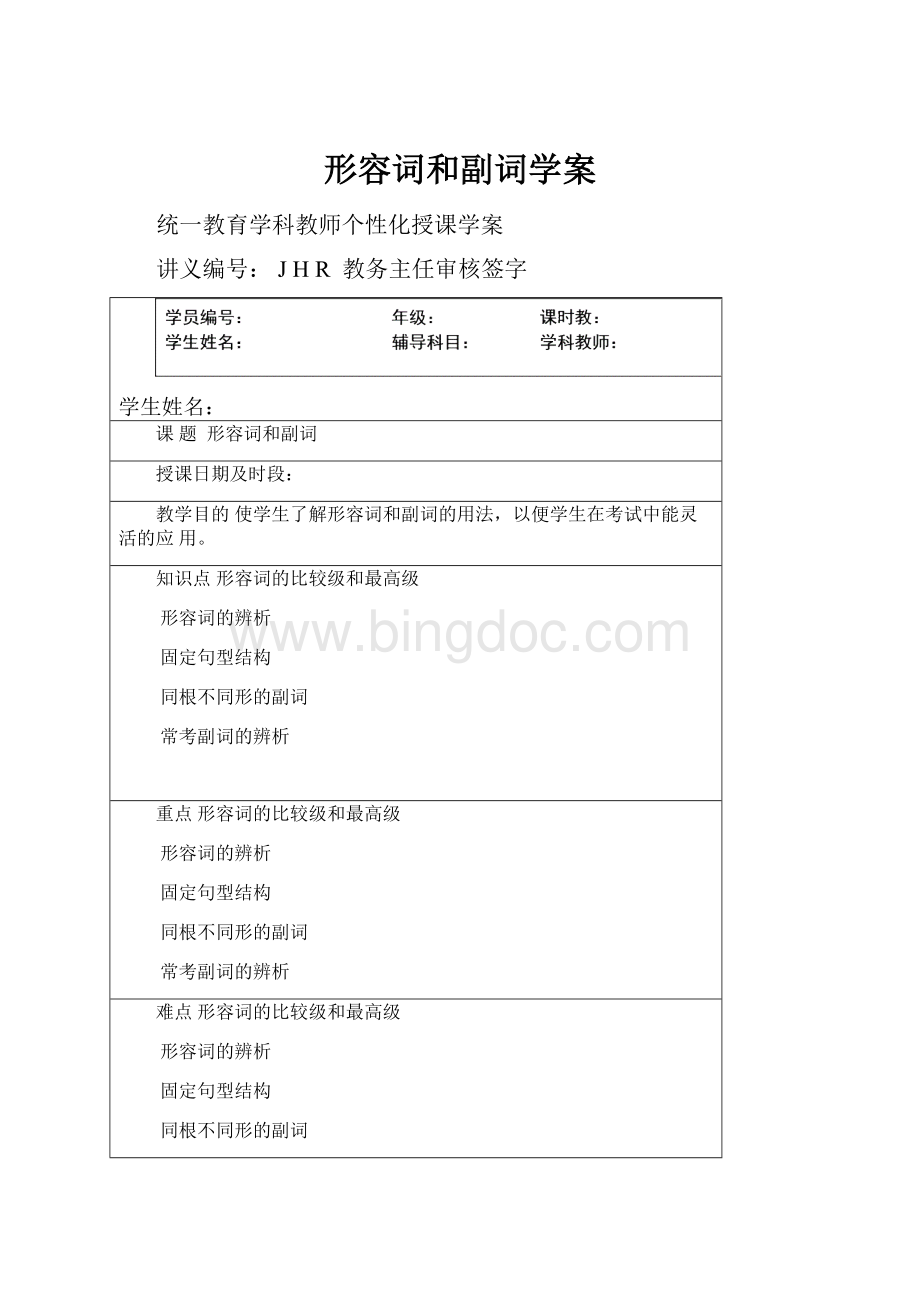形容词和副词学案.docx
《形容词和副词学案.docx》由会员分享,可在线阅读,更多相关《形容词和副词学案.docx(16页珍藏版)》请在冰点文库上搜索。

形容词和副词学案
统一教育学科教师个性化授课学案
讲义编号:
JHR教务主任审核签字
学生姓名:
课题形容词和副词
授课日期及时段:
教学目的使学生了解形容词和副词的用法,以便学生在考试中能灵活的应用。
知识点形容词的比较级和最高级
形容词的辨析
固定句型结构
同根不同形的副词
常考副词的辨析
重点形容词的比较级和最高级
形容词的辨析
固定句型结构
同根不同形的副词
常考副词的辨析
难点形容词的比较级和最高级
形容词的辨析
固定句型结构
同根不同形的副词
常考副词的辨析
考点形容词的比较级和最高级
形容词的辨析
固定句型结构
同根不同形的副词
常考副词的辨析
技能提升能够灵活的使用形容词和副词,并能够清楚的判断副词在句中的句法功能。
教学效果自评及课后反思
教学进程和教学内容
形容词
一、形容词的作用与功能
形容词修饰名词,说明事物或人的性质或特征。
在句中作定语、表语、宾语补足语和状语等。
1.作定语
Inyourletteryouaskedaboutthetimeindifferentareasofthestates.
2.作表语
I’mfine,buttired.
注意:
有些形容词通常作表语,常见的有well,ill(生病)以及a开头的部分形容词,如
afraid,alike,alive,alone,asleep,awake等。
Evenwhenyouareasleepyouareusingenergy.
Ihopeyouweren’till.Youdon’tlookverywell.
3.作主语补足语
Thefishwascaughtalive.
4.作宾语补足语
Nowyouhavetopullittomakethesurfacesmoothlikethat.
5.作状语
Awomanwaslyinginbed,awake,listeningtotherushingwinds.
二、形容词的位置
1.形容词作定语通常放在它所修饰的名词前面
anintelligentboy
apairofbeautifullittleridingboots
2.在下列情况下形容词要放在后面
1)形容词作定语修饰some,any,every,no和body,thing,one等构成的复
教学进程和教学内容
合不定代词时需后置。
Thereisnobodyabsenttoday.
Iwanttotellyousomethingimportant.
2)以-able或-ible结尾的形容词可置于前面有最高级形容词或only等词的名词之后。
Thisisthebestbookavailable.
Thatistheonlysolutionpossible.
3)以前缀a-开头的某些形容词,如:
alike,alive,afraid,awake,aware,asleep等,可置于only等词修饰的名词之后。
Hewastheonlypersonawakeatthemoment.
4)和空间、时间单位合用时。
twomonthsago
arulertwelveincheslong
5)形容词enough一般需后置,但也可以前置。
Ihavemoneyenough.
=Ihaveenoughmoney.
6)成对的形容词可以后置
Therewasahugeroomsimpleandbeautiful.
Shehasmanypencils,blueandred.
7)形容词短语一般需后置,往往相当于定语从句。
Weneedaplacetwicelargerthanthisone.
Amansodifficulttopleasemustbehardtoworkwith.
3.某些形容词作前置定语和后置定语的区别
英语中有些形容词既可作前置定语,也可作后置定语,但意义不同。
常作后置定语的形容词有absent,concerned,elect,involved,present,proper,responsible等。
theabsentprofessor
theprofessorabsent
theresponsiblegovernment
教学进程和教学内容
thegovernmentresponsible
三、复合形容词
1.数词+名词(单数)
onechild three-hour
2.数词+名词(单数)+形容词
three-year-old six-inch-tall
800-meter-long
3.数词+名词+ed
One-handed ten-storeyed
two-footed three-legged
4.形容词+(普通)名词
full-timesecond-hand
first-ratehigh-class
mid-term
5.形容词+名词+ed
kind-hearted cold-blooded
noble-minded warm-hearted
6.形容词(副词)+现在分词
ugly-looking common-looking
hard-working easy-going
ever-lasting
7.形容词(副词)+过去分词
new-born well-dressed
ready-made well-known
deep-set near-sighted
8.形容词(副词)+形容词
dark-red light-blue
all-round wide-awake
教学进程和教学内容
9.名词+现在分词
life-savingmouth-watering
ocean-going peace-loving
English-speaking world-shaking
10.名词+过去分词
hand-made heart-broken
11.名词+形容词
ice-cold life-long
world-famous snow-white
heart-long
12.名词+(普通)名词
X-ray English-language
副词
副词主要用来修饰动词、形容词、副词或其他结构。
一、副词的类别
1.时间副词now,then,today,tomorrow,ago,lately,soon,immediately,often,usually,early
2.地点副词 outside,upstairs,anywhere,up,forward,here,there,away,inback,off
3.方式副词simply,quickly,happily,loudly,suddenly,luckily,again,once,easily,together
4.程度副词 very,quite,rather,extremely,completely,widely,partly,perfectly,badly,too
5.疑问副词 when,where,why,how
6.关系副词 when,where,why
7.连接副词 when,where,why,how
8.其他 surely,certainly,really,however,therefore,perhaps,moreover,yes,no
二、副词的句法功能
副词修饰动词、形容词或副词,说明动作或状态的特征。
教学进程和教学内容
1.作
Heworkedhardallhislife.(修饰)
Heplaystennisverybadly.(修饰)
2.作
Sorry,Mr.Smithisn’tin.Heisout.
3.作(通常)
Onourwayhome,wesawatrafficaccident.
4.作
IsawyououtwithMr.Whiteyesterdaymorning.
三、副词的位置
1.副词修饰形容词、副词时,应放在被修饰成分之前,但enough必须位于被修饰的词之后。
如:
Thisbookisquiteinteresting.
Theboyisoldenoughtogotoschool.
2.频度副词(always,often,usually,never,seldom,hardly,sometimes等)要放在实义动词之前,be动词、助动词、情态动词之后。
ChildrenoftengototheparkwiththeirparentsonSundays.
3.地点副词、时间副词、方式副词常位于句末。
Irememberseeingyousomewhere.
4.同时出现几个副词的排列顺序:
方式副词→地点副词→时间副词。
Mr.Browndrovehiscarquicklyoutsidethen.
5.修饰全句的副词多置于句首。
Fortunately,hewasnotdrownedandwassavedbythePLAmen.
教学进程和教学内容
四、兼有两种形式的副词
1.close与closely
close意思是“近”;closely意思是“仔细地”
Heissittingtome.
Watchhim.
2.late与lately
late意思是“晚”;lately意思是“最近”
Youhavecometoo.你来晚了。
Whathaveyoubeendoing?
最近在忙些什么?
3.deep与deeply
deep意思是“深”,表示空间深度;deeply时常表示感情上的深度,“深深地”。
Hepushedthestickintothemud.他把棍子深深地插到地里。
Evenfatherwasmovedbythefilm.
甚至父亲也被这部电影深深的打动了。
4.high与highly
high表示空间高度;highly表示程度,相当于much。
Theplanewasflying.
Ithinkofyouropinion.
5.wide与widely
wide表示空间宽度;widely意思是“广泛地,在许多地方”。
Heopenedthedoor.
Englishisusedintheworld.
6.free与freely
free的意思是“免费”;freely的意思是“无限制地”。
Youcaneatinmyrestaurantwheneveryoulike.
Youmayspeak;saywhatyoulike.
教学进程和教学内容
形容词与副词的比较级与最高级
一、构成
大多数形容词(性质形容词)和副词有比较级和最高级的变化,即原级、比较级和最高级,用来表示事物的等级差别。
原级即形容词的原形,比较级和最高级有规则变化和不规则变化两种。
1.规则变化
单音节词和少数双音节词,加词尾-er,-est来构成比较级和最高级。
1)一般单音节词末尾加-er,-est,如tall(高的)—taller—tallest
2)以不发音的e结尾的单音词和少数以-le结尾的双音节词只加-r,-st,如nice(好的)—nicer—nicest,large(大的)—larger—largest,able(有能力的)—abler—ablest
3)以一个辅音字母结尾的闭音节单音节词,双写结尾的辅音字母,再加-er,-est,如big(大的)—bigger—biggest,hot(热的)—hotter—hottest
4)“以辅音字母+y”结尾的双音节词,改y为i,再加-er,-est,如easy(容易的)—easier—easiest,busy(忙的)—busier—busiest
5)少数以-er,-ow结尾的双音节词末尾加-er,-est,如clever(聪明的)—cleverer—cleverest,narrow(窄的)—narrower—narrowest
6)其他双音节词和多音节词,在前面加more,most来构成比较级和最高级。
如important(重要的)—moreimportant—mostimportant,easily(容易地) —moreeasily—mosteasily
2.不规则变化
原级 比较级最高级
good(好的)betterbest
well(健康的)
bad(坏的)/worseworst
ill(有病的)
old(老的)older/elderoldest/eldest
much/many(多的)moremost
little(少的)lessleast
far(远的) farther/further farthest/furthest
教学进程和教学内容
二、比较级的用法
1.双方比较,表示一方超过另一方时,用“比较级+than”的结构表示。
如:
Thispenisbetterthanthatone.
2.表示一方不及另一方时,用“less+原级+than”的结构表示。
如:
Thisroomislessbeautifulthanthatone.
3.表示一方超过另一方的程度或数量时,可在比较级前加表示程度的状语:
even,alot,abit,alittle,still,much,far,yet,byfar等修饰。
如:
Heworksevenharderthanbefore.
注意:
英语的比较级前如无even,still,或yet等时,译成汉语时可用“较”或“……一些”或不译出,一般不可用“更”,如:
Sheisbetterthanshewasyesterday.
Pleasecomeearliertomorrow.
4.表示一方随另一方的程度而变化时,用“the+比较级(主语+谓语),the+比较级(主语+谓语)”的结构。
如:
Theharderheworks,thehappierhefeels.
5.不与其他事物相比,表示本身程度的改变时,用“比较级+and+比较级”的结构。
如:
Thegirlbecomesmoreandmorebeautiful.
6.某些以or结尾的形容词进行比较时,用to代替than。
(这些词有inferior,superior,junior,senior,prior等)。
如:
HeissuperiortoMrWanginmathematics.
7.在比较从句中为了避免重复,我们通常用that(those),one(ones)代替前面出现的名词。
that指物,one既可指人,也可指物。
that可代替可数名词单数和不可数名词,而one只能代替可数名词。
如:
Aboxmadeofironisstrongerthanonemadeofwood.
8.表示倍数的比较级有如下几种句型:
1)Aisthree(four,etc.)timesthesize(height,length,width,etc)ofB.如:
Thenewbuildingisfourtimesthesize(theheight)oftheoldone.
2)Aisthree(four,etc.)timesasbig(high,long,wide,etc.)asB.如:
AsiaisfourtimesaslargeasEurope.
3)Aisthree(four,etc.)timesbigger(higher,longer,wider,etc.)thanB.如:
Yourschoolisthreetimesbiggerthanours.
用times表示倍数,一般只限于表示包括基数在内三倍或三倍以上的数。
表示两倍可以用twice或double。
三、最高级的用法
1.三者或三者以上相比,表示最高程度时,用“the+最高级”的结构表示。
这种句式一般常有表示比较范围的介词短语。
如:
ZhangHuaisthetallestofthethree.
2.最高级可被序数词以及much,byfar,nearly,almost,bynomeans,notquite,notreally,nothinglike等词语所修饰。
如:
Thishatisbyfar/much/nearly/almost/notnearly/bynomeans/notquite/nothinglikethebiggest.
3.表示“最高程度”的形容词,如excellent,extreme,perfect等,没有最高级,也不能用比较级。
4.形容词最高级修饰作表语或介词宾语的名词、代词时,被修饰的词往往省略。
如:
Heisthetallest(boy)inhisclass.他是班里最高的(男生)。
5.作状语的副词最高级前可以不加定冠词。
如:
Ofalltheboyshecame(the)earliest.在所有的孩子中,他来得最早。
如果复数名词前有many,few,不可数名词前有much,little等表示量的形容词时,该用so而不用such。
如:
I’vehadsomanyfallsthatI’mblackandblueallover.
但little不表示数量而表示“小”时,仍用such。
如:
Theyaresuchlittlechildrenthatthetheycannotcleanthehousebythemselves.
6.almost与nearly
教学进程和教学内容
1)两者都可以修饰all,every,always等词,都可以用于否定句中。
2)在very,pretty,not后用nearly,不用almost。
如:
I’mnotnearlyready.
3)在any,no,none,never前用almost,不用nearly。
如:
Ialmostneverseeher.
【考点诠释】
考点1形谷词、副词的比较等级
1.形容词或副词的as…as结构
两者相比,当A=B时,用“as+adj./adv.原级+as”来表示。
如:
JackrunsasfastasTom.
双方相比,当A≠B,或指A的程度较低时,用“notas/so+adj./adv.原级+as”表示。
如:
Hedoesnotworkas/sohardashissister.
2.形容词或副词的比较级+than、
当双方比较,A>B时,用“比较级+than”结构。
当A不及B的程度时,用“less+adj./adv.原级+than”的结构。
如:
①Bloodisthickerthanwater.
②Healthisbetterthanwealth.
3.表示双方相比,一方超过另一方,并强调超出的程度和数量时,可在比较级前加表示程度的状语,如:
even,much,verymuch,still,any,alot,abit,alittle,far,yet,byfar,agreatdeal,twice,threetimes,rather,slightly等,而very,quite,so,fairly等词不可修饰形容词或副词的比较级
Acarrunsagreatdealfasterthanatruck.
4.“the+比较级,the+比较级”结构表示“越……越……”
Themoreticketsyousell,themoremoneyyouwillget.
5.当三者或三者以上相比,表示最高程度时,用最高级这种句式中一般常有表示比较范围的介词短语;最高级可被序数词以及much,byfar,nearly,almost,bynomeans,notquite,notreally,nothinglike等修饰。
如:
Thebuildingbeingbuiltnowisbyfarthehighestinthecity.
教学进程和教学内容
6.比较级表示最高级含义
1)比较级+thananyother+可数名词单数。
如:
TheChangjiangRiverislongerthananyotherriverinChina.
在中国,长江比其他任何一条河流都长。
2)比较级+thanall(the)other+可数名词复数。
如:
ChinaislargerthanalltheotherAsiancountries.
3)no/never/nothing…+比较级。
如:
Nothingismorevaluablethantime.时间比任何东西都珍贵。
4)“否定词+不定冠词+形容词的比较级+名词”或“否定词+副词的比较级”表示“从未……;未曾……”。
如:
Thisfilmisverymoving.Ihaveneverseenabetterone.
这部电影很感人,我从没有看过一部比它更好的。
考点2形容词、副词的辨析
1.形容词主要用来修饰名词,也可修饰something,nothing等不定代词,在句中作定语、表语、宾语补足语或状语。
作状语时表示伴随、原因等,或是对主语进行解释,可以看成是“being+形容词”,位于句首、句中或句尾,表示伴随时通常用逗号与其他成分隔开
①Helayinbed,wideawake.
②Hewenttobed,coldandhungry.
2.有些副词有两种形式,其中一种形式与形容词形式相同,另一种是在形容词后加ly。
这两种形式的副词在意义上有所不同:
不带ly的